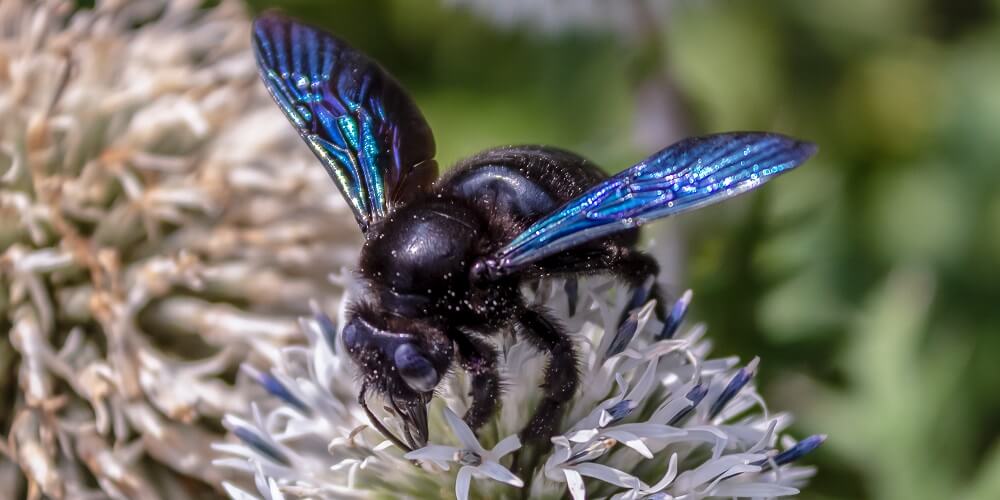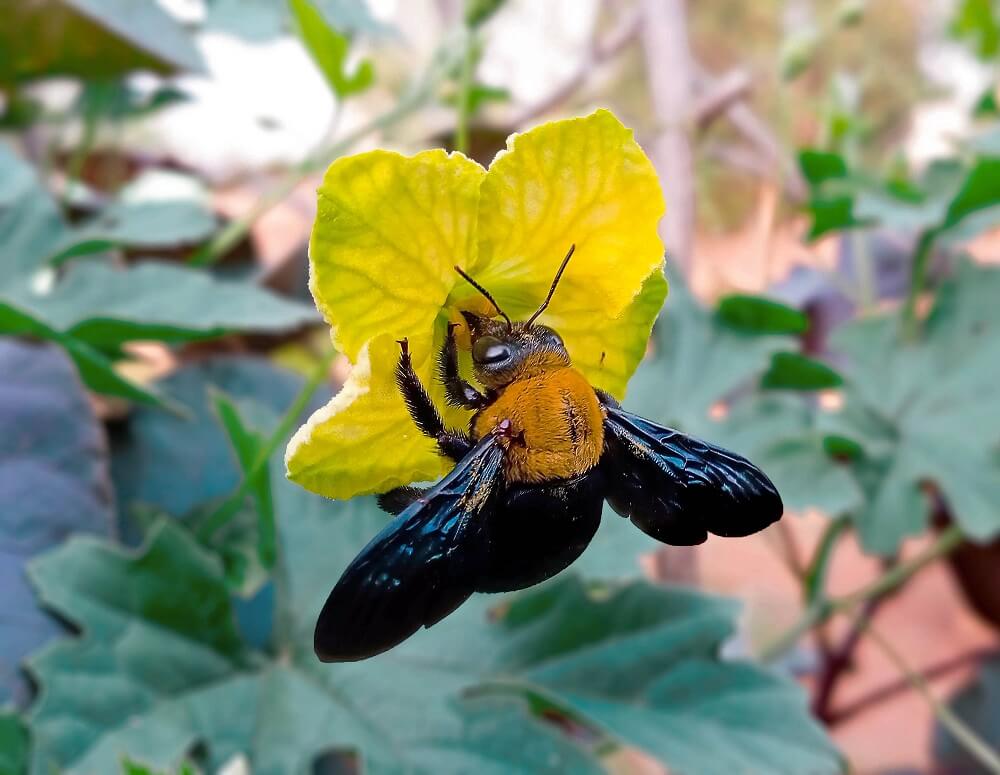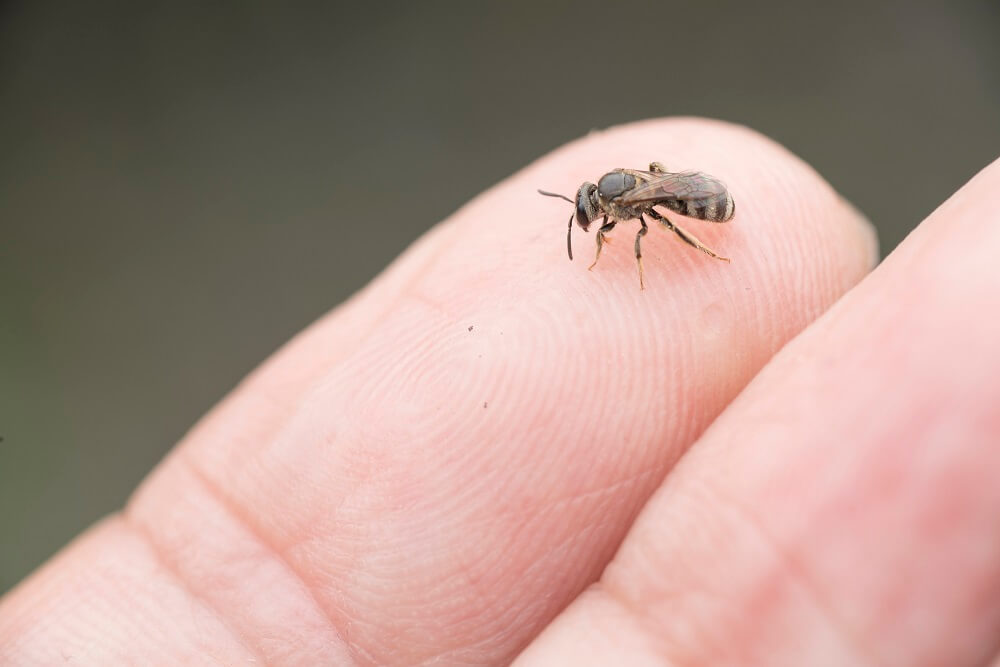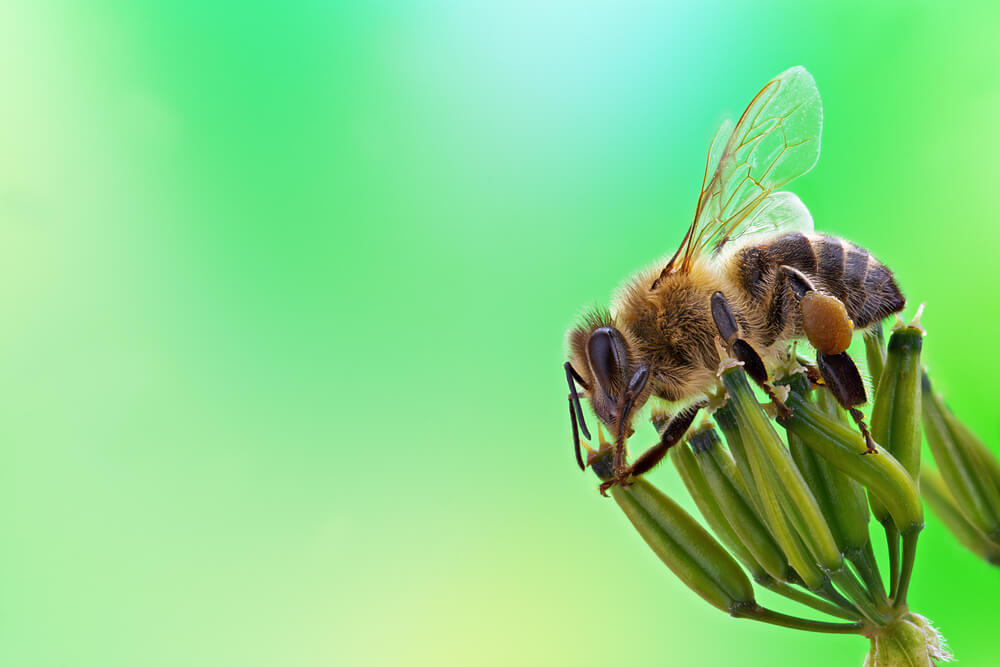Table of Contents:
How Many Wings Does a Bee Have?

Bees have four wings, two larger wings on top and two smaller ones on the bottom.
Want to hear something surprising?
Bees can beat their wings almost four times faster than hummingbirds can. The fastest recorded rate of a hummingbird was 80 beats per second. Bees can beat their wings up to 230 beats per second.(1)
In other words?
Bees’ wings move so fast that you can’t even see them.
They just look like they’re hovering through the air. So that’s why scientists watch slow-motion videos to better study bees’ wings.
Speaking of slow-motion videos…
Check out this clip of bumblebees flying:
Pretty cool, right?
A bee’s wings work together to act as one large surface. This helps the bee gain greater lift when flying. But since bees’ wings aren’t rigid, they can twist and rotate them in mid-flight.
So despite popular belief:
Bees don’t flap their wings up and down like birds do. They actually beat them in a slight figure-8 pattern. These tiny movements can be hard to see, even if you’re watching a bee fly in slow motion. But these short, choppy rotations are what generates incredible speed.(2, 3)
And the cool part?
These wing rotations create a whirlwind like a small tornado. Bees can lift their body forward, backward, up, and down by rotating the air around them. And like hummingbirds, bees can hover in midair.
Michael H. Dickinson, Professor of Bioengineering at the California Institute of Technology, says, “These animals are exploiting some of the most exotic flight mechanisms that are available to insects.”(4)
Can a Bee Live Without Wings?

No, bees can’t live without wings. Bees need wings to perform their daily duties such as eating, drinking, and nesting.
And sadly?
Bees can’t grow their body parts back like reptiles can. For example, a lizard can regrow their tail if they lose it.
Bees aren’t so fortunate.
This means a bee’s life will be greatly shortened if it loses a wing in an accident. This is especially true for solitary bees, who live alone and can’t rely on colony members to help them out. Remember, wings are a bees’ primary mode of transportation.
And more specifically?
If bees can’t fly due to a damaged wing, they can’t forage for pollen or nectar from flowers. Pollen and nectar are bee’s main food sources, so they’ll starve without them.
But what about their legs? Can’t bees just walk?
Yes, bees can walk, but they need their wings for long-distance travel. Keep in mind that not all bees have the luxury of living next to a field of flowers. This means it’s not uncommon for bees to fly over three miles in search of food.

Bees also have to make multiple trips from flowers back to their nests. They can’t do this without wings.
Speaking of their nests:
Most hurt bees won’t be able to safely return to their nests in the first place. This is a problem because they need shelter to protect themselves from predators and bad weather. For example, heavy raindrops can knock bees down and hurt them because they’re so small.
Even worse?
A damaged wing puts a bee at risk to predators such as birds, skunks, and wasps.
But here’s the good news:
Sometimes a bee looks hurt when it actually isn’t.
So if you see a bee resting on a flower and not moving, don’t assume the bee is injured. Sometimes they just take little breaks because they work over 10+ hours per day foraging for pollen and nectar.
What Are Bee’s Wings Made of?

Bee’s wings are made of chitin (KITE-IN), a substance that forms the exoskeletons of insects.
In short:
Chitin most closely resembles the protein keratin, which is the material that makes up your fingernails.
Bees also have veins in their wings filled with hemolymph, or insect blood. Their wings have nerves and air tubes, giving their wings strength and stability.
And like mentioned, bees have exoskeletons. So unlike humans who have skeletons under our skin, bees wear their skeletons outside of their bodies. So bees don’t have internal bones like mammals do.
Instead, a bee’s exoskeleton helps protect its delicate internal organs, conserves internal body fluids, and serves as a protective layer against bacteria.
In a nutshell?
A bee’s wing is a part of its exoskeleton. And you’ll notice that bee wings are thin and transparent. You can see through them like clear glass.
So it might make you wonder:
Are bees wings delicate?
Not as delicate as you might think. Bee’s wings are built to carry them long distances. And not only that, but some bees can carry up to 80% of their body weight. They need strong wings to make this happen.

Sure, bee wings look delicate. But that’s probably because we’re only judging them from a human standpoint.
Take bodyweight as an example.
An average worker honeybee weighs 0.11 grams. If you compare that to a 180-pound person, that’s almost a 200% difference.
So what’s my point?
It’s important to look at bees from an insect perspective instead of a human perspective. Bees are strong little insects that work hard. That’s why some people have even referred to bees as the heavyweights of the insect world.
So bees may appear small and delicate to humans, but they’re actually tough little creatures. They’re also full of interesting habits that are fun to study.
FAQs on “How Many Wings Does a Bee Have?
- Can bees fly in bad weather?
- Where are bees’ wings located?
- Why do bees look like they only have two wings?
- How many sets of wings does a bee have?
- How many wings does a bumblebee have?
- What do bees use their wings for?
- Can I help a bee with a hurt wing?
- Why shouldn’t you clip a queen honeybee’s wings?
Can bees fly in bad weather?
Some bees, like bumblebees and carpenter bees, can fly better in windy and rainy weather than other bees can. This is because bumblebees and carpenter bees are larger than other bees.
But in most cases, bees don’t fly in bad weather because the rainfall can weigh their bodies down.
—> Go back to the FAQs on “How Many Wings Does a Bee Have?”
More to Explore:
Where are bees’ wings located?
A bee’s wings are attached to its thorax. The thorax is the upper part of the body between the bee’s abdomen and head. And although bees are small, they have strong thorax muscles that allow them to beat their wings incredibly fast.
Take a look at this picture:

Let’s face it.
Bees are strong little insects. Bumblebees have been known to carry up to 80% of their body weight when bringing food back to their hive. That’s like a 180-pound person carrying a backpack weighing 144 pounds.
It’s incredible.
Dr. Susan Gagliardi, a research associate in the College of Biological Sciences at UC Davis, said this about it:
“[Bumblebees] can carry 60, 70, or 80 percent of their body weight flying, which would be a huge load for us just walking around.”(5)
—> Go back to the FAQs on “How Many Wings Does a Bee Have?”
More to Explore:
Why do bees look like they only have two wings?
Here’s the thing:
Due to their size, it can be hard to tell that bees have four wings. The wings also lay close together – sometimes overlapping – so it can be tricky to spot the separation between the wings.
Take carpenter bees, for example.
Look at the beautiful colored wings on this carpenter bee:

Her wings are gorgeous. But do you notice how it looks like she only has two wings?
However, she actually has four: two large wings at the top (forewings) and two small ones at the bottom (hindwings). The wings lay close together, so it can be hard to spot them.
Here’s another picture of the same carpenter bee, where you can better differentiate her four wings:

—> Go back to the FAQs on “How Many Wings Does a Bee Have?”
More to Explore:
- Why Do Vulture Bees Eat Rotting Flesh?
- How Long Do Bumble Bees Live?
- Honeybees vs. Bumblebees: How Do They Compare?
How many sets of wings does a bee have?
Bees have two pairs of wings which make for four wings in total. The two front set of wings are called the forewings and the two back set are called the hindwings.
—> Go back to the FAQs on “How Many Wings Does a Bee Have?”
More to Explore:
How many wings does a bumblebee have?
We frequently get asked this question, along with dozens of other similar questions like:
How many wings does a honey bee have? How many wings does a queen bee have? How many wings does a sweat bee have? Do all bees have 2 sets of wings? How many wings does a normal bee have? How many wings does a bee have in total? How many pairs of wings does a bee have? How many sets of wings does a bee have?
The answer?
All bees have four wings which equal two pairs on each side. Also, it’s worth mentioning that this includes all species of bees, including bumblebees, mason bees, sweat bees, honeybees, and so on.
—> Go back to the FAQs on “How Many Wings Does a Bee Have?”
More to Explore:
What do bees use their wings for? Why do bees have four wings?
It might surprise you to learn that bees use their wings for more than just flying.
In fact, bees use their wings for various activities:
1. Bees communicate with each other using their wings
Think about it.
Bees need to communicate to relay important information, such as if the hive is in danger or where food is located.
Let’s use honeybees as an example.
Every honeybee colony has different roles assigned to different bees. For example, “scout bees” are responsible for finding food. So they take off from the hive – sometimes traveling several miles – to find a good source of nectar and pollen.
Once they find it, they need to communicate the location of food sources to the other bees in the colony.
How do they do this?
By doing a “waggle dance.”
The waggle dance is a specific movement that conveys information about the direction and distance of the food source. Other bees in the colony watch the dance and then fly off in the same direction as the food.
During the waggle dance, the bees wave her body from side to side and produce sounds by vibrating her wings. This is a special “bee language” that her colony understands.
2. Bees flap their wings to regulate temperature
For instance, bumblebees can fly in temperatures as low as 50°F (10°C), but they can’t take off unless their flight muscles are above 86°F (30°C).
So in cool temperatures, bumblebees need to warm themselves up so they can fly. So she’ll start by “pumping” her body to ventilate her flight muscles. Then she’ll vibrate her wing muscles to generate heat.
Honeybees are also known to flap their wings to regulate temperatures.
In the winter, honeybees form a cluster around the queen to keep her and each other warm. In addition, they’ll quickly vibrate their wings to generate heat.
Even better?
Honeybees use their wings to cool the hive, too.
During the summer, honeybees will fill their stomach with water, fly back to the hive, then regurgitate the liquid. Other bees then spread the water out around the hive. The water evaporates and helps reduce the temperature.
In addition to that, though, the bees will also fan the hive with their wings to cool things off.
3. Honeybees use their wings to make honey
During the honey making-process, bees fan their wings over the nectar inside the wax cells. This causes the excess water to evaporate which allows the nectar to thicken into honey. After that happens, the bees will cap the honeycomb.
—> Go back to the FAQs on “How Many Wings Does a Bee Have?”
More to Explore:
Can I help a bee with a hurt wing?
Unfortunately, there isn’t much you can do to help a bee with an injured wing.
Bees need their wings to survive and do things like fly, communicate, and collect food. So if a bee’s wing is severely damaged, it’s likely that the bee won’t live much longer.
If you find a bee with an injured wing, the best thing you can do is leave it alone and let nature take its course.
But here’s the thing:
We often get emails from kind people who want to help bees with hurt wings. I understand how upsetting it is to see a hopeless bee.
That said, sometimes bees appear hurt or tired when they’re actually just resting. The bee may only need a few minutes to recoup before it flies off.
Also, because bee’s wings appear ragged, it doesn’t mean they’re actually injured. Like humans, bees’ bodies will age over time, so their wings may get frayed as they grow older. This is completely natural.
—> Go back to the FAQs on “How Many Wings Does a Bee Have?”
More to Explore:
Why shouldn’t you clip a queen bee’s wings?
This is a common question amongst beekeepers.
Fortunately, clipping a queen honeybee’s wings is mostly an outdated practice.
Why?
A few reasons.
For one, some beekeepers believe that clipping wings is like cutting nails or hair – painless and no big deal. This is not true. A clipped queen is an injured and defective bee.
Remember:
Bee wings have nerves, air tubes, and veins in them. These veins carry insect blood (hemolymph) from their body, through their wings, and back out again. Wings have nerves, so it’s extremely painful when you cut a bee’s wing.
Secondly, clipping a queen’s wings will not prevent the colony from swarming.
Swarming happens when the hive gets too big, and the workers decide to split the colony into two and move elsewhere. Your colony will swarm regardless of whether your queen is clipped or not. So you win nothing by cutting up the queen.
Thirdly, clipping a queen isn’t a smart way to track the year she was born.
Some beekeepers argue that clipping is easier than using a dot of paint because paint wears off. Still, clipping isn’t worth it because the worker bees will sense their queen is “defective,” and they’ll replace her more quickly than they would if she was left alone.
And lastly?
Some beekeepers clip their queen’s wings to mark how valuable she is. My thought is this: You shouldn’t mutilate something valuable to you.





